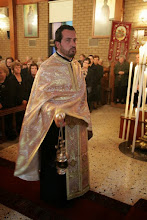Athos Forum

athosforum.org
Scholars
Benedict, left during the revolution, taught at the priestly school of Poros founded by Kapodistrias, returned to the Monastery, where he died in 1840. The sequence he wrote on the icon of the Virgin of "Axion estii" was published. There are anecdotes and other works of his, sequences and eulogies.
Procopios Dendrinos followed the same course. He left during the revolution, taught at the school of Poros and returned to his Monastery to die in 1848. In 1814 he printed a new edition, at the expense of the Monastery, of Thikara in lasion.
In 1831 in Aegina the Guide, or Introduction to the Holy Scriptures...
In 1832 in Nafplion the Egolpion hieron, That is, the study of Evidence from the Holy Scriptures...
In 1835 in Constantinople the Reconstruction. Almost verbatim, the Anti-origin Original Sin Unseen Booklet...
In 1841 in Athens a catechism with the title Christian Teaching, i.e. Holy Catechism of the correct doctrines...
loannis Symeonidis, from the Macedonian country of Tarlizi, and former Teacher of the School in Megalo Turnovo, published in
Pesti in 1840, in Greek, the work Kipos Polyanthis, which contains plants of various kinds...
Azarias printed in Constantinople in 1861 in a bilingual edition (Greek and Russian) Anotera episkiasis pir Athos, That is,
stories about Saints and Miracle Workers and Icons of the Virgin Mary and other Saints glorified on Athos.
Around 1840,
Hieronymos Solomegov settled in the Monastery, who set up a printing press and devoted himself mainly to the printing of enlightening leaflets about Mount Athos and especially about the Monastery of Agios Panteleimon, which were widely distributed in Russia, which contributed to the massive attendance of monks from there.
Calligrapher in the 19th century, Dionysios Agiartemitis in Penteleimonos.
Athos forum - Calligrapher in the 19th century, Dionysios Agiartemitis in Penteleimonos.
www.purebibleforum.com



